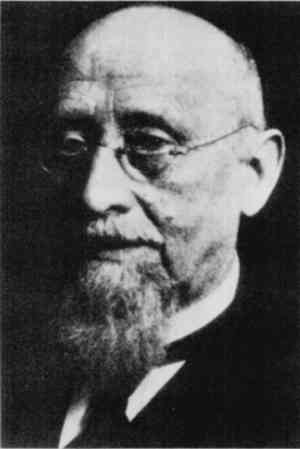FRIEDRICH RATHGEN: THE FATHER OF MODERN ARCHAEOLOGICAL CONSERVATIONMark Gilberg
1 INTRODUCTIONFor many conservators, particularly those within the English-speaking world, the publication of Harold Plenderleith's The Preservation of Antiquities in 1934 marked the beginning of what has been loosely described as “modern” archaeological conservation (Plenderleith, 1934). This handbook has long been considered the “bible” of conservation and has, until relatively recently, served as the standard textbook on the subject. Unfortunately, its widespread adoption has often given rise to the impression that the author and the British Museum alone made significant early contributions to the field. A number of other individuals, however, did much to promote the development of archaeological conservation prior to this date. Among these, the most prominent place belongs to Friedrich Rathgen (Fig. 1).
Friedrich Rathgen was the first Director of the Chemical Laboratory of the Royal Museums of Berlin. From its inception in 1888 until his retirement in 1927, Rathgen was intimately involved in the development and application of chemical and physical methods for the conservation of antiquities. Though probably best known for his handbook Die Konservierung von Alterumsfunden [The Conservation of Antiquities] first published in 1898 (Rathgen, 1898) and translated into English in 1905 (Rathgen, 1905), Rathgen published well over sixty papers on the technology and conservation of archaeological artifacts. Rathgen was the first scientist to be employed in a laboratory associated with a museum. A chemist by profession, Rathgen was the first to adopt a scientific approach to the treatment of museum artifacts. Historically, archaeological conservation was intimately associated with the individual crafts. Thus, it was only natural when help was needed for the preservation of archaeological materials to turn to experienced craftsmen who were familiar with that particular medium. Thus, the earliest treatment methods were largely empirical and not necessarily based upon scientific principles. Failure to understand these principles frequently led to rather dubious explanations for why antiquities deteriorated while promoting seemingly ridiculous treatment methods. Rathgen was quick to recognize the need for a more systematic approach to the conservation of antiquities, seeking an explanation for their deterioration through an understanding of the mechanism by which archaeological materials, such as clay, stone and metal, corrode or decay. His work did much to dispel many of the prevailing “myths” associated with the decay of antiquities, and as a result he was responsible for many of the most important developments in the treatment of archaeological materials. In this respect Rathgen was one of the first to realize that museum artifacts could be provided by craftsmen, and that if progress was to be made, it would be made through the development of treatment methods specifically within the field of conservation itself. In this realization lies the inception of conservation as a separate discipline and for this reason alone Rathgen may well be considered the “father” of modern archaeological conservation. A number of excellent biographies of Rathgen have been published in the archaeological literature (Brittner, 1943; Hiecke, 1942/1943; Otto, 1979; and Riederer, 1976). Despite the comprehensive nature of these biographies, they do not fully reflect the role which Rathgen played in the development of archaeological conservation. In the following work Rathgen's major accomplishments in the field of conservation will be discussed in terms of their impact upon the development of archaeological conservation. |
